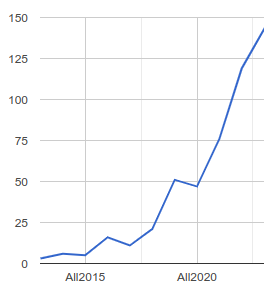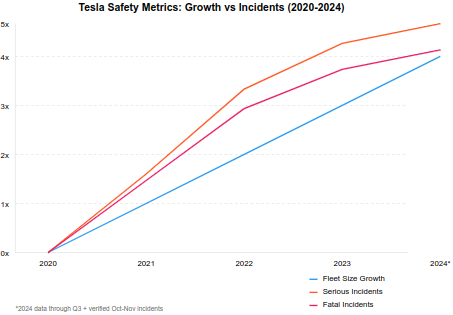Industry Average: 2.8 per billion miles
Tesla’s fatality rate is double the industry average
Source: iSeeCars 2024 Safety Study
| Year | Fleet Size Growth | Serious Incidents | Fatal Incidents | Key Patterns |
|---|---|---|---|---|
| 2020 | 1x (baseline) | 1x | 1x | Autopilot crashes into stationary objects |
| 2021 | 1.5x | 1.8x | 1.6x | Motorcycle collisions emerge as pattern |
| 2022 | 2x | 3x | 2.6x | First confirmed FSD-related fatality |
| 2023 | 2.5x | 4.2x | 3.5x | Multiple 4+ fatality crashes, door failures |
| 2024* | 3x | 5x | 4x | 22+ deaths in Oct-Nov alone; immediate-ignition fires |
* 2024 data through Q3 + verified Oct-Nov incidents. Source: NHTSA FARS database and verified incident reports
Executive Summary
In my decades of experience in safety engineering, I’ve witnessed vehicles evolve from death traps to marvels of information technology that save lives daily. However, Tesla’s trajectory defies a positive trend by signaling not progress but a dangerous regression while billing itself as a utopian investment (e.g. advance fee fraud). Between 2018 and 2024, Tesla’s vehicles displayed a disturbing pattern of harm from predictable engineering failures, resulting in death rates significantly exceeding industry norms. Immediate-ignition fires and inoperable electronic door systems are just the most visible symptoms today of a deeper systemic crisis, which Tesla has aggressively downplayed by shifting blame to drivers while avoiding accountability for design flaws.
The Evolution of a Crisis
2018-2020: Warning Signs Ignored
Tesla’s problems didn’t arise overnight. Early incidents hinted at recurring design flaws: crashes caused by Autopilot failures, misidentifications of hazards, and post-impact electronic malfunctions. Gao Yaning and Josh Brown, killed by their driverless algorithm, in 2016 were early harbingers. Yet, Tesla plowed ahead with expansion, using intentional disinformation campaigns of utopia to distract from dangerous warnings (like pointing to a shiny mirage in the desert while selling water bottles labeled “self filling”).
2021-2022: Trends Emerge
By 2021, the cracks became harder to ignore. Motorcycle-related fatalities highlighted Tesla’s known inability to detect objects including pedestrians and smaller vehicles. Sudden unintended acceleration (SUA) events and “veering” incidents grew far more common, joined by new horrors: crashes accompanied by instant fires and failed egress systems. Tesla’s vaunted safety ratings rang obviously hollow, as yet another intentional disinformation distraction from reality.
2023: A Critical Turning Point
Full Self-Driving (FSD) brought fresh risks and even more harms. Veering incidents tripled, and the first confirmed FSD fatality occurred in July (Pablo Teodoro III). By year-end, multiple-fatality events became disturbingly routine. A deadly fire in a Model Y trapped the occupants, reinforcing fears about Tesla’s reliance on poorly designed fragile electronics for life-critical systems. To be clear, at that time I called it out here:
Increasing Evidence Tesla Drivers Burn to Death While Unable to Open Any Door
2024: A Catastrophic Failure to Regulate
The final quarter of 2024 was catastrophic: October and November alone saw over 22 fatalities, including three separate incidents claiming 4+ lives each. Once again, intense post-crash fires and failed door systems emerged as defining factors of “death trap” by design, trapping victims and leaving first responders helpless.
Systemic Problems: Patterns Behind the Headlines
Uniquely Deadly Crash Fires
Tesla crashes frequently involve immediate, intense fires from design flaws, making occupant rescue nearly impossible. This contrasts with traditional vehicle fires (frequently electrical too), where a much more delayed ignition with multiple safeguards provides crucial rescue windows. Notably, none of the other EV models selling at or even above Tesla into the hundreds of thousands have reported the explosion of fire deaths.
Basic Door Design Failures
Tesla’s excessively complicated and sub-quality electronic doors often fail after impact, locking occupants into a complex puzzle while being burned alive as rescuers struggle in vain to access the cabin.
Widespread Failures Across Modes
Whether operating in manual mode, Autopilot, or FSD, the same failure patterns — veering, SUA, and crashes with severe fires — occur with disturbing regularity. Reflect back on an angry CEO telling the world there would be no safer car and anyone who disagreed should be ridiculed as a threat to safety.

Disproportionate Incident Growth
Tesla’s fleet tripled between 2020 and 2024, but severe incidents increased by five times. This isn’t a function of scale; it points to design flaws.
Statistical Evidence
- Fatal Accident Rate: Tesla leads the industry at 5.6 deaths per billion miles (vs. 2.8 for all brands).
- Dangerous Models: Both the Model Y and Model S rank among the 23 most dangerous cars despite their advanced technology.
- Fleet Impact: Tesla’s fatality rate is five times higher than industry averages for comparable vehicles.
Corporate Denial: A Dangerous Culture
Tesla’s reaction to these failures reveals more about their priorities than any marketing campaign ever could. Instead of addressing the issues:
- They tout crash test ratings while ignoring real-world outcomes.
- They blame drivers, deflecting scrutiny from clear engineering flaws.
- They attack critics, including NHTSA analyses, labeling concerns as “clickbait.”
- They mislead with selective statistics, citing total miles driven while ignoring disproportionate per-mile fatality rates.
Recommendations for Action
- Mandated Reporting: Regulators must require Tesla to report all incidents involving fires, door system failures, SUA, and veering. Transparency is the first step toward accountability.
- Engineering Audits: Independent reviews of Tesla’s safety systems—particularly fire prevention, egress mechanisms, and electronic resilience—are overdue.
- Consumer Protections: Tesla must provide clear warnings about the risks of their designs, alongside revised safety ratings based on real-world outcomes.
Conclusion: Beyond the 1950s Comparison
Tesla’s failures represent a regression not just to outdated safety standards, but to the reckless disregard of a pre-safety era. Their vehicles’ reliance on electronics for life-critical systems without adequate fail-safes has introduced modern hazards that didn’t exist even in the unsafe cars of the 1950s. Until Tesla confronts their self-inflicted systemic failures head-on, their alarming and unique fatality count will continue to climb, many preventable tragedies at a time.
The warning signs are glaring. The solutions are as obvious as ever.
It’s time for regulators to step in and call the fraud a fraud. Who can ensure Tesla’s promises of total fiction, which experts repeatedly warn it can never deliver, won’t continue to kill hundreds of innocent victims?

Tesla Deaths Per Year Accelerating Predictably

